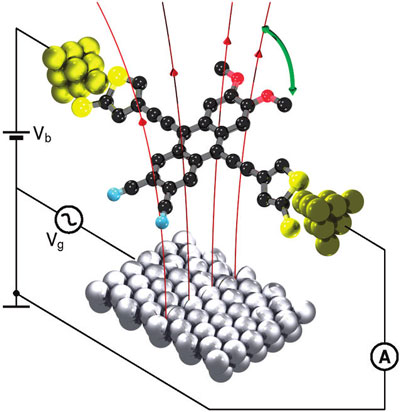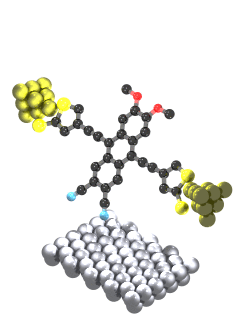| Posted: Dec 02, 2010 | |
An electric motor made from a single molecule |
|
| (Nanowerk Spotlight) A fast-growing body of nanotechnology research is dedicated to nanoscale motors and molecular machinery. For the visionary goals of nanotechnology, functional and perhaps autonomous molecular motors will play an essential part, just like electric motors can be found in many appliances today. These nanomachines could perform functions similar to the biological molecular motors found in living cells, things like transporting and assembling molecules, or facilitating chemical reactions by pumping protons through membranes. | |
| Although applications of molecular motors are still in the future, the results of early-day studies are already spectacular: well-designed molecules or supramolecules show different kinds of motion – fueled by different driving forces such as light, heat, or chemical reactions – resulting in molecular shuttles, molecular elevators and rotating motors. | |
| A team of researchers in The Netherlands is now proposing a conceptually new design of molecular motor based on electric field actuation and electric current detection of the rotational motion of a molecular dipole embedded in a three-terminal single-molecule device. | |
| "We have shown that it is feasible to both drive a motor consisting of a single molecule and measure its rotation using electric fields" Johannes S. Seldenthuis tells Nanowerk. "Although motors powered by light or heat are useful for driving large assemblies of molecules at once, it is very difficult to apply a force locally to drive a single molecular motor. With an electric field this becomes much easier. Moreover, the speed of rotation can be controlled very accurately by varying the frequency of the electric field." | |
| Seldenthuis, a member of Herre S. J. van der Zant's Molecular Electronics and Devices group at TU Delft's Kavli Institute of Nanoscience, is first author of a recent paper in ACS Nano ("An All-Electric Single-Molecule Motor") where the team shows that the use of an electric field to drive a molecular dipole motor provides unidirectionality and complete control over the speed of rotation, while the conductance provides a real-time measure of the motion. | |
| Detection of the rotation of a molecular motor is a non-trivial issue. For large surface assemblies this can be accomplished by, for example, measuring the combined effect of many rotating molecules on a macroscopic object (see for instance "Molecular machines: Nanomotor rotates microscale objects"). | |
| However, the motion single molecule between electrodes is too small to image directly. What the TU Delft team has shown is that for a particular type of molecule, so-called conjugated molecules, which have a high conductance, it is possible to measure the rotation by looking at the variation in the conductance. | |
| "Conjugated molecules prefer to be planar, and if they are, their conductance is high" explains Seldenthuis. "However, when the rotor starts to turn, the conductance drops. It is therefore possible in principle to measure the rotation angle of the rotor by looking at the conductance." | |
| The design of the motor consists of anchoring groups connecting the conjugated backbone to the leads, allowing the measurement of the low-bias conductance, and a dipole rotor which can be driven by the oscillating gate field underneath. The rotating moiety is equipped with a permanent electric dipole moment and is part of a conjugated molecule, which is suspended between two metallic contacts above a gate electrode. | |
 |
|
| Design of a molecular motor with a permanent electric dipole moment. (Reprinted with permission from American Chemical Society) | |
| Just to be clear, though, at the moment this design for an all-electrical single-molecule motor exists only on paper. However, certain parts have already been verified experimentally – the possibility of exerting a force on a molecular dipole with an electric field, and the angular dependence of the conductance of a conjugated molecule. | |
| "We have shown that it should be possible to drive and measure the proposed molecules in our current setups" says Seldenthuis. "So while this is an exciting step forward in the field of molecular motors, the only experimental difference for us is the type of molecule we put in our setups. We believe this makes our design a very feasible proposal. Many challenges may of course still lie ahead, but the design is both simple and versatile enough that we should be able to realize it in the coming years. We are already talking to chemists who have expressed an interest in synthesizing the proposed molecules, and we hope to begin the first measurements sometime next year." | |
| He points out that, although the proposed motor uses an external gate electrode to drive the molecule, the team have shown that the charging or discharging of a neighboring molecule should also provide an electric field large enough to drive the motor. This should make it in principle easier to incorporate our motor in a molecular machine than the light or heat-driven motors. | |
| Apart from making and measuring the motor, the main challenge ahead is control over the direction of rotation. This is true for almost all molecular motor designs thus far. | |
| "We have shown that, once it's coupled to the electrodes, our molecule should only rotate in one direction" notes Seldenthuis. "However, which direction that is depends on how it is positioned in the junction, something over which we do not have control. We are currently looking into ways to make the molecule always prefer one direction over the other. The main challenge after that would be to combine the motor with other components in order to create a functional machine. However, this is one of the biggest challenges in the entire field of molecular electronics." | |
| An important aspect of the design is the versatility offered by chemical synthesis. In particular, the barrier height, the dipole moment, and the moment of inertia of the rotor can all easily be changed. | |
| "Our motor therefore constitutes a well-defined nanoelectromechanical system suitable for studying molecular motion over a wide range of temperatures, encompassing both the classical and quantum regime" says Seldenthuis. | |
| Molecular motors have always been one of the most fascinating concepts in the field of nanotechnology. The Dutch researchers have been working for years on making electrical components – transistors, rectifiers, LEDs etc. – out of single molecules, but it is only recently that they discovered that their setups have evolved to the point where mechanical components are within reach. | |
 |
|
| This animation shows the rotation of the motor in an oscillating field. (Source: Molecular Electronics and Devices group, Kavli Institute of Nanoscience) | |
| Reference: Seldenthuis, J., Prins, F., Thijssen, J., & van der Zant, H. (2010). An All-Electric Single-Molecule Motor ACS Nano, 4 (11), 6681-6686 DOI: 10.1021/nn1021499 | |
 By
Michael
Berger
– Michael is author of three books by the Royal Society of Chemistry:
Nano-Society: Pushing the Boundaries of Technology,
Nanotechnology: The Future is Tiny, and
Nanoengineering: The Skills and Tools Making Technology Invisible
Copyright ©
Nanowerk LLC
By
Michael
Berger
– Michael is author of three books by the Royal Society of Chemistry:
Nano-Society: Pushing the Boundaries of Technology,
Nanotechnology: The Future is Tiny, and
Nanoengineering: The Skills and Tools Making Technology Invisible
Copyright ©
Nanowerk LLC
|
|
|
Become a Spotlight guest author! Join our large and growing group of guest contributors. Have you just published a scientific paper or have other exciting developments to share with the nanotechnology community? Here is how to publish on nanowerk.com. |
|
